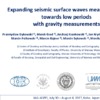Dykowski P., M. Grad, A. Krankowski, J. Kryński, T. Olszak, M. Polkowski, M. Rajner, M. Sękowski i M. Wilde-Piórko. „Expanding seismic surface waves measurements towards low periods with gravity measurements”. Joint Symposium / J09. Geodesy and seismology general contributions. Kobe, Japonia.
- [bib]
@conference{Dykowski2017,
}eventtitle = {Joint Symposium / J09. Geodesy and seismology general contributions}, year = {2017}, title = {Expanding seismic surface waves measurements towards low periods with gravity measurements}, author = {Dykowski, Przemysław and Grad, Marek and Krankowski, Andrzej and Kryński, Jan and Olszak, Tomasz and Polkowski, Marcin and Rajner, Marcin and Sękowski, Marcin and Wilde-Piórko, Monika}, date = {2017-08-04}, month = {aug}, address = {Kobe, Japonia}, presenter = {Przemysław Dykowski}, - [streszczenie]
Seismic and gravity measurements are usually considered as separate scientific problems, although both are related to the same object – the Earth. Seismometers do not measure gravity field change and seismic events in gravity measurements are considered as disturbances and are usually removed from the records. The nature of tidal gravity measurements, especially superconductive gravimeters records, allows determining very long periods of seismic surface waves. Variety of broadband seismometers allow measuring surface waves up to period of 120-150 seconds, while superconducting gravimeters record surface waves up to 400-500 seconds. This is of great importance for structure studies, because waves of longer periods make possible studying deeper structures of the Earth. In this presentation, it has been shown how simultaneous seismic and gravity records at the same locations allow studying very long period surface waves. For test purposes 4 seismometer-gravimeter pairs have been deployed in Poland. These configurations are placed at three locations, Borowa Gora Geodetic-Geophysical Observatory (bg), Jozefoslaw Astronomical-Geodetic Observatory (joze), and Lamkowko Satellite Observatory (lamk). Three seismometers are paired with two types of LaCoste&Romberg spring gravimeters (et and model G) at all those Observatories. Additionally one seismometer is co-located on the same pillar with the iGrav-027 superconducting gravimeter at bg location. During the test period from December 2016 to January 2017 several large teleseismic events were observed with well-formed surface waves. Together with expected next events they should give dispersion curves for long surface waves, as well as periods of free oscillations. The correlation of a broadband seismometer signal with different types of gravimetric sensors gives a possibility to analyze gravimeter noise components, in the instrumental and microseismic domains.
